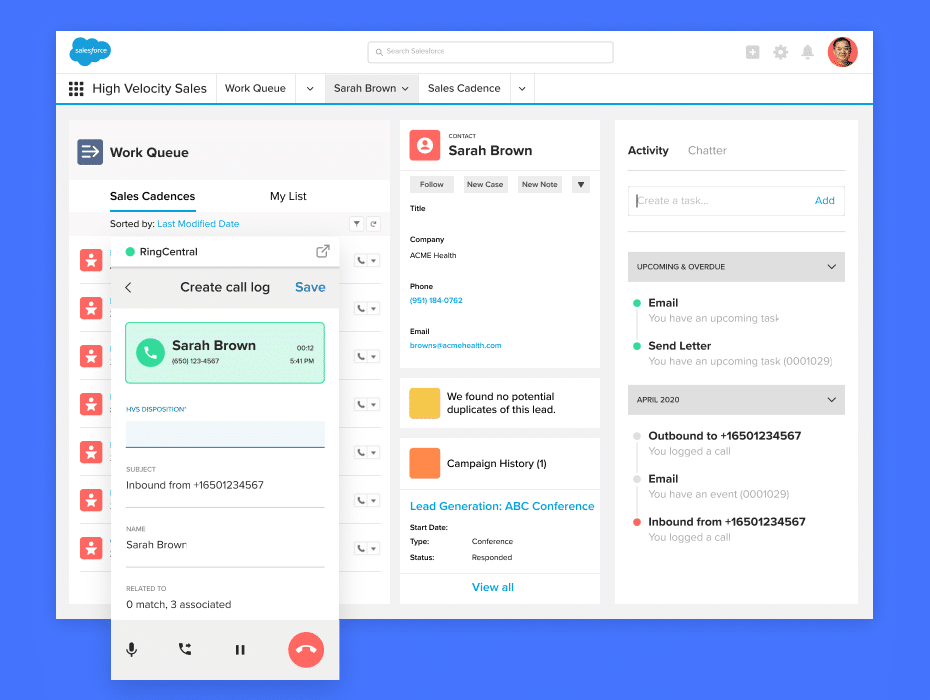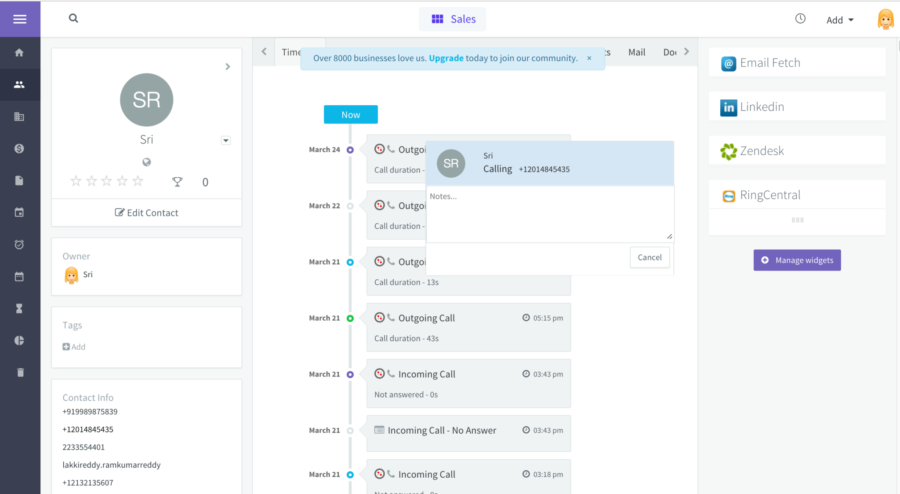Whether your sales process begins with a lead downloading something, reaching out, or your own cold emails, you probably know that it’s going to take more than one conversation to close the sale.
And while you might be tempted to wing it, you can benefit from using a sales cadence (that is, reaching out in a set sequential order) to help you stay on track and keep an eye on all of your leads.
By offering a set structure and email cadence you always follow, you can avoid embarrassing mistakes or missed opportunities—and close more deals, too.
While you may think a sales cadence is a tool reserved for larger sales teams, implementing one at your small business can be beneficial—even if you’re the sole sales rep.
The right sales cadence keeps things consistent and trackable across your business. Sales flow smoothly, prospects are less likely to leak out of the pipeline, and onboarding new team members is easier too.
But with a sales cadence that’s too rigid, your process might feel too pushy or too slow for certain prospects. The key is striking the balance between a prescribed sales cadence and real-life variations.
As a company that’s built a product to facilitate a ton of sales conversations, we know that the right conversations, at the right time, can make or break your small business.
So, we’ve put together some ideas for creating a sales cadence that works for you. Here’s what we’ll cover today:
- How to create a sales cadence that works for your business
- Adapting your sales cadence to customer needs
- Essential sales cadence software to improve effectiveness—there are only two!
Up your sales productivity game and close more deals with these free cold outreach scripts. ☎️
How to create a sales cadence that works
Consistency and structure
The cornerstone of a sales cadence that works is structure. And, while we’ll later look at ways to deviate and adapt your sales cadence for a specific customer, the foundation should really be consistency.
Without structure and consistency, you don’t really have a sales cadence at all, and you definitely don’t have one that works. The point of a sales cadence is to create a template that you can apply to your process.
And, while some variation is appropriate, the system mostly works because you’re able to stick to that template. In fact, if you find yourself consistently editing your sales cadence template, it’s probably a good sign that you should go back to the drawing board
When you’re creating your sales cadence, it’s important to think through your normal sales process and also to think through all touchpoints—including email, phone calls, and even social media.
From there, create a structure that incorporates enough touchpoints to keep leads interested, but not so many that they get annoyed. Unfortunately, we can’t tell you exactly how many conversations that is, because it’s going to vary by industry and product.
Then, stick to the process, at least for a while, in order to see how it works—over time, it will become clear whether it’s working.
That consistent structure will make onboarding new team members easier, keep you from embarrassingly sending the same email twice (whoops!), and avoid leads slipping out of the pipeline.
Focus on the lead
It always bears repeating: your entire sales cadence should be focused on your lead. That means their needs, the considerations that matter to them, and the sales objections that will come up for them should be your main focus.
Keeping everything hyper relevant is the best way to avoid reading as annoying, and instead makes you look genuinely helpful.
If you really want your sales cadence to work for you, the first step is some research.
Once a lead is in your system, do your best to figure out some crucial details about them—are they the main decision maker? What social media sites are they on? Where are they located?
The most relevant questions to ask are obviously going to depend on your product, so make a list of your own and store it in your CRM. That way, you’ll be able to keep the rest of your sales cadence focused on helping them.
Via email, that means sending content that is helpful or educational for them. Not just articles or case studies, but case studies from customers like them, or articles about the challenges they’re facing.
If you have a few different kinds of customers that you frequently encounter, you can even save email templates that are most relevant to each.
On the phone, every conversation should tie back to how the customer would benefit from making a purchase with you. A good salesperson can tactfully identify and remind the lead of pain points they’re experiencing by not using your product.
It’s a natural way to introduce some urgency into the conversation and to keep your sales cadence effective.
Track and refine
The best thing about implementing a consistent sales cadence is that it gives you the ability to examine your process and understand what’s working. Without that consistency, you can’t really use data to understand what works and what doesn’t for your customers—all feedback is anecdotal.
Once you implement your sales cadence, start tracking. Some of the things you might want to look at include:
- How many times do you reach out to a lead before getting a response?
- How many touches does it take before a prospect agrees to a sales call, a demo, or before you close the deal?
- How many leads open, click, or reply to each of your emails?
- How many sales are made through this sales cadence?
There may be other metrics that are important to your business, but the important thing is to be intentional about tracking these numbers or to use a CRM that can help you keep track.
Then, after a set amount of time or when it becomes obvious what’s working and what’s not, you can refine your sales cadence to better suit your customers. Instead of relying on customer feedback or guessing, you’ll have the numbers to back up your instincts.
How to adapt your sales cadence to customer needs
While consistency is ideal when it comes to your sales cadence, sometimes, it makes sense to adapt to customer needs. After all, you might cater to different kinds of customers, and some leads are always going to come in warmer than others.
By adapting your sales cadence based on customer needs, you can create the best result for everyone and move at a speed that works for you. The key? Make note of any shifts to your usual sales cadence in your CRM.
Editing the timing while keeping the content of your sales cadence the same will make tracking your process easier, but if a particular customer is email averse, you may not have that option. That’s why tracking is crucial if you’re going to edit your sales cadence, so you can easily see what information a customer may be missing.
Ready to adapt your usual sales cadence? Here are some things to keep in mind first.
Understand your market position
When it comes to creating and then adapting your sales cadence, it’s crucial to have an understanding of your product and how it fits within the larger market.
Some of the questions that will help you adapt your sales cadence include:
- Is your product complex or straightforward? Do leads usually know what they’re looking for or is more education necessary to explain your solution?
- How does your pricing fit among your competitors? If you are a budget option, how do your features compare? If you are a premium option, do your features, support, or setup justify the added expense?
- Do customers in your space generally make decisions independently or with the help of a team? Who is generally the key decision maker on purchases?
- For subscriptions, what is a normal contract length? When in this period do customers usually shop around? Is there a purchasing schedule to be aware of (fiscal year, school year, holidays, etc.)?
Not only will understanding your product and market position help you to tailor your sales cadence as a whole, but it will also help you adapt it when necessary for certain leads.
It will be immediately obvious if a lead falls outside of the situation that would work for your normal sales cadence, and you can adapt accordingly.
Listen to your customer
In addition to understanding your market and product, you also need to have an understanding of your customer. You can do this both on a general level through personas and individually on a case-by-case basis.
We’ve already discussed the importance of focusing on the lead, but that focus on them can also give you clues on the right sales cadence that’s going to result in a sale.
Buyer personas are a great way to get in your customers’ heads and understand what they may be looking for during the sales process.
Using your existing customers as a template, create at least one buyer persona to understand the factors that may stretch or shorten your usual sales cadence. Do they need to consult with someone else before making a purchase? Is this a rush situation because their existing solution failed?
Creating personas may also allow you to create a few different options for sales cadences or a couple different email templates so you send the right content to the right lead.
Knowing your customer doesn’t have to just be in the general sense, though. When you make contact with a lead, you can also listen for key differentiators that might determine your sales cadence with them specifically.
If, for instance, they’re looking for a quick solution, you may need to shorten your usual timeline. If they’re waiting out an existing contract, you may need to find more content to extend your usual cadence.
They may also give information about the kind of content they want or need in order to make a decision, so it’s critical to listen closely and adapt accordingly.
Be clear about next steps
At every touchpoint, get clear on what the next steps for the sales conversation will be. Will you schedule a call to go over budget? Will you get other decision makers involved?
By focusing on the next step, your lead will naturally give you clues as to their timeline and the sales cadence that will work best for them.
For instance, they might say, “Well, you can talk to my manager, but we’re not going to make a decision until we see proposals from three companies.” That gives you a clearer idea of their timeline and also lets you know that a proposal will be a critical element for this sale.
On the other hand, if they’re asking how soon you can schedule a follow-up, it’s a clue that you can speed up the sales cadence for this particular customer.
Essential sales cadence software to help you close deals consistently
In most cases, there are two main types of software to help you maintain a good sales cadence: you need the communication or cold email outreach software that allows you to dial and message your prospects; and a CRM to build your database and record conversations or other touchpoints.
1. A communication platform (aka what you need to do the actual outreach)
Years and years ago, this would’ve just been a simple telephone. (Or your own two feet, if you’re going door to door.)
But today, there are much better ways to get in touch with prospects. And no matter what you settle on for your final sales cadence, you need a way to actually execute on it and contact those prospects—that’s where your communication platform comes in.
You need options. Yes, phone calls are still big, but what if you had a library of scripts right in your cold calling software? And what if it automatically tracks your outreach campaigns? Let’s see how that might look—here’s how it works in RingCentral Engage Voice:
RingCentral Engage Voice is an all-in-one outbound solution that can handle your internal chat, gives you a business phone number, and lets sales reps view important customer information, all in one place.
Plus, you can sell from anywhere because RingCentral is a cloud solution. That gives you the flexibility of making work calls from your mobile device or laptop from just about anywhere in the world.
When it comes time to make a sales call, flexible, personalized scripting appears on the screen so you can deliver a consistent, high quality, on-brand experience, or just be sure you don’t forget any details. And, after the call, you can easily add follow-up notes, automate the process of scheduling a follow-up call, or move the lead further along your sales cadence.
Plus, with integrations that connect to your CRM, billing platform, and more, you can always have the most relevant information in front of you for any call or email.
The integration with Salesforce, for instance, allows you to dial a prospect right from the CRM interface and associate the call activity back to leads or customers:

Not using Salesforce? RingCentral has integrations for HubSpot, Zoho CRM, Agile CRM, and many other tools that sales teams love:

🕹️ Get a hands-on look at how RingCentral works by booking a product tour:
💰 You can also use this calculator to see roughly how much your business could save by using RingCentral to support your team’s communication with each other—and clients.
Now, let’s look at the other sales must-have.
2. A CRM
The other software that’s crucial to executing on your sales cadence is, of course, your CRM. As every sales rep knows, your CRM is critical to your success.
But when it comes to creating a strong sales cadence, it will be especially helpful to invest in a CRM that accommodates that sequence and can manage and track activities.
When looking at CRM options, keep in mind the features that will help you optimize your sales cadence for success:
- Lead importing, depending on where your leads usually come from
- Note taking, lead tracking, and sales activity tracking
- Integrations with your communications and billing platforms
- Email automation
- Automated metric tracking for each phase of your sales cadence
With a strong communications platform and a CRM to track sales activities, you’ll have the technology tools to back up your sales cadence.
Ready to create a sales cadence that adapts to meet customer needs?
If your sales process is leaking leads, causing embarrassing mixups, or just not working for you, it’s time to try a sales cadence. By creating consistency and structure, the right sales cadence keeps leads engaged, but not annoyed, and helps you close more deals.
While a sales cadence provides much-needed structure to the sales process, it also runs the risk of being too rigid to fit every customer.
By freeing yourself to adapt your cadence to customer needs, you can gain the benefits of a template while still providing the personalized attention that every lead requires.
Originally published Jan 05, 2021, updated Jun 19, 2024





